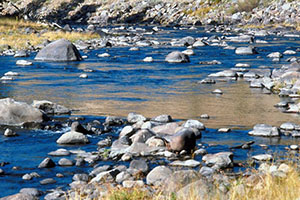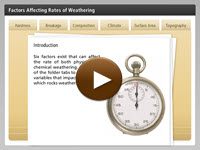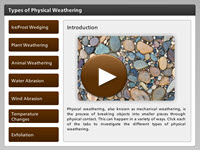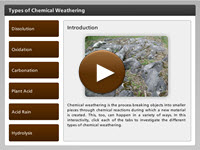
Weathering
 Earth’s surface is always changing. The internal forces of the Earth can cause the crust to rise. These processes will form large mountain ranges or build up the surface through volcanic activity. At the same time, external forces will break apart the exposed rock and move the pieces to a lower elevation. The breaking down of Earth’s rocks is known as weathering. Weathering is the simple process of breaking rock into smaller pieces. Weathering can occur in a variety of ways in many different environments; however, most cases of weathering occur at Earth’s surface. Rocks at the surface of the earth are vulnerable to weathering because the surface of the Earth is constantly exposed to the Sun, forces of weather, plants, animals, and other factors. There are two basic methods of weathering: physical weathering and chemical weathering.
Earth’s surface is always changing. The internal forces of the Earth can cause the crust to rise. These processes will form large mountain ranges or build up the surface through volcanic activity. At the same time, external forces will break apart the exposed rock and move the pieces to a lower elevation. The breaking down of Earth’s rocks is known as weathering. Weathering is the simple process of breaking rock into smaller pieces. Weathering can occur in a variety of ways in many different environments; however, most cases of weathering occur at Earth’s surface. Rocks at the surface of the earth are vulnerable to weathering because the surface of the Earth is constantly exposed to the Sun, forces of weather, plants, animals, and other factors. There are two basic methods of weathering: physical weathering and chemical weathering.
Physical weathering, also known as mechanical weathering, is the process of breaking objects into smaller pieces through physical contact. This can happen in a variety of ways. In this interactivity, click on each of the tabs to investigate the different types of physical weathering. Click the player button to begin.
View a printable version of the interactivity.
Chemical weathering is the process breaking objects into smaller pieces through chemical reactions during which a new material is created. This, too, can happen in a variety of ways. In this interactivity, click each of the tabs to investigate the different types of chemical weathering. Click the player button to begin.
View a printable version of the interactivity.
Rates of Weathering
 When a rock is broken into smaller pieces, physical weathering increases the surface area that can be exposed to further weathering. Imagine that you have a cube made of rock. There are six possible sides that can be weathered. In this example, the length and height of the cube are both 4 centimeters. This makes the area of the cube 16 centimeters2. The surface area of the cube, or the total area that is exposed to weathering is 96 centimeters2.
When a rock is broken into smaller pieces, physical weathering increases the surface area that can be exposed to further weathering. Imagine that you have a cube made of rock. There are six possible sides that can be weathered. In this example, the length and height of the cube are both 4 centimeters. This makes the area of the cube 16 centimeters2. The surface area of the cube, or the total area that is exposed to weathering is 96 centimeters2.
Now, assume this cube is broken into eight pieces through physical weathering. Will the surface area exposed to weathering increase or decrease? You can see that after weathering there are still six sides that can be weathered. The broken cubes all have an area of 4 square units. Each cube still has six sides that are exposed to weathering. Instead of one cube, eight cubes now exist. This makes the total surface area exposed to weathering 192 centimeters2. As weathering takes place, the surface area exposed to weathering increases.
 Factors Affecting Rates of Weathering
Factors Affecting Rates of Weathering
Some rocks break very easily and quickly, while other rocks resist weathering or take thousands or even millions of years to break down. In this activity, click on each of the steps to explore the variables that affect the rate at which rocks weather. Click the player button to begin.
View a printable version of the interactivity.
Weathering Review
![]()
 Now that you have explored weathering, practice what you have learned. In this non-graded activity read each question, and then select the appropriate answer. Click the player button to get started.
Now that you have explored weathering, practice what you have learned. In this non-graded activity read each question, and then select the appropriate answer. Click the player button to get started.




